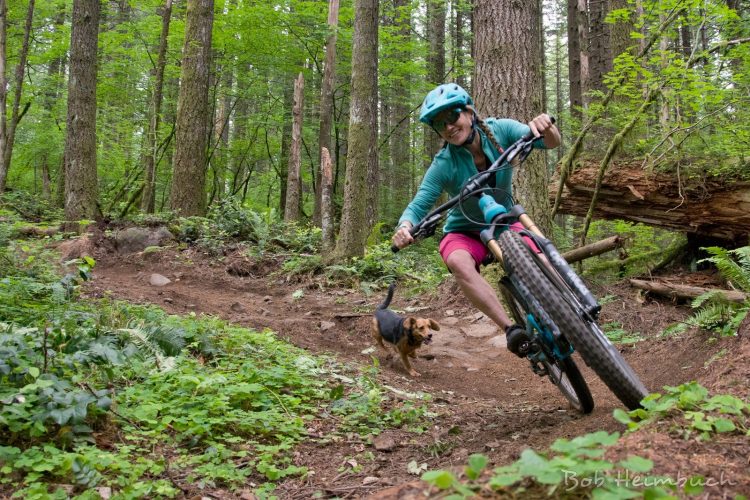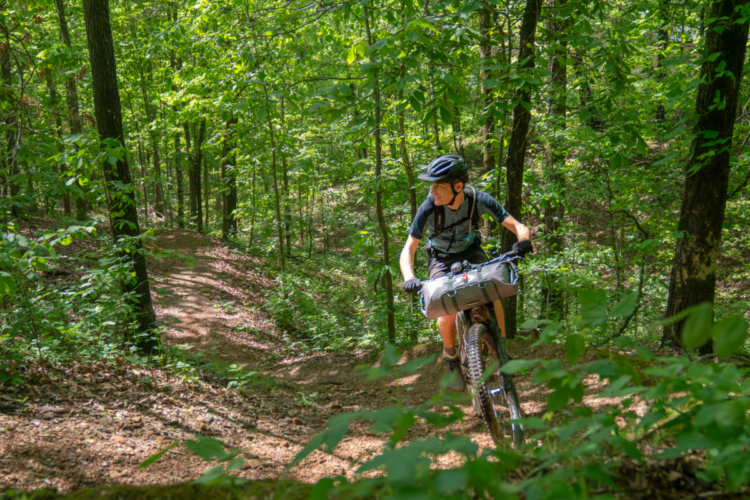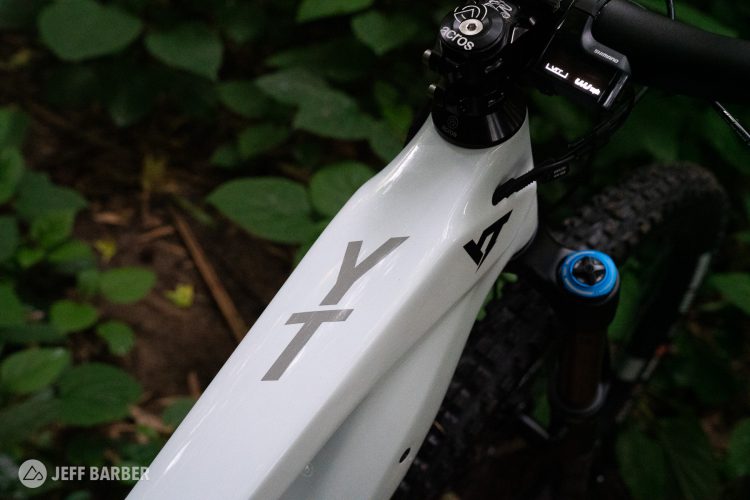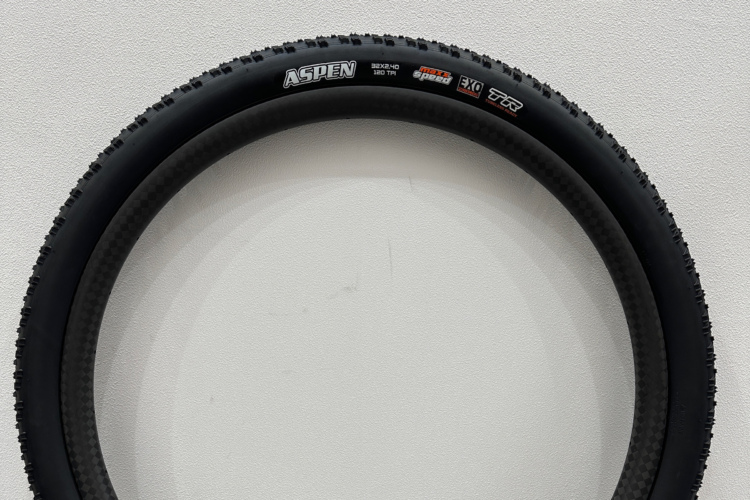Earlier in the fall Greg wrote a post about riding Horsethief Bench, one of the most popular trails in the Kokopelli Loops Trail System near Fruita, Colorado. In his post, Greg stated, “Horsethief Bench has fallen prey to its own popularity. . . it looks like it has been loved to death.”
This gave me pause. First of all, as a local, Horsethief is a trail that is near and dear to my heart. Reading any sort of negative comment about it gets under my skin a little bit and makes me want to say, “Hey! You don’t know what you’re talking about!” But after that knee-jerk reaction, I stopped and thought: “What if Greg has a point? What if it has been loved to death?“
After a great ride on Horsethief last week, a ride in which we saw two groups of 8-12 riders each plus a couple of groups of 2 or 3, Adelle and I sat at the top of the entrance, watching folks drop down a large piece of rock (the first obstacle of any sort on the trail). We talked about the state of Horsethief, and Adelle said, “Maybe Horsethief is our sacrificial lamb. We offer it up to the tourists so we can go ride other trails like Lions and Mack without crowds.”
“Loved to death,” in my mind, means that a trail looks pitiful. It has braids, obvious unsanctioned “ride arounds,” areas where the singletrack has widened, and places where the original obstacle of a trail isn’t even ridden over anymore because so many cheater routes have been created. It just looks worn out in places.
An area at Kokopelli that used to be singeltrack has widened over time–so much so that users have started trying to edge the trail with rocks to prevent further widening.
So if Horsethief and other popular trails have been loved to death, how does that happen? How does a trail get “loved to death”? I posed the question to some friends here that bike, and also to the Facebook community. Some possibilities were:
1. Ignorance. If you live in a place and you’re familiar with a trail, then you know the “right” routes to take. If you’re a visitor and you’re riding a trail for the first time, you don’t have that local’s knowledge. Out here in the desert, one person taking an unsanctioned route can leave a mark. Riders new to the area head out, get to an indistinct part of the trail, see that unsanctioned path, follow it, and the next thing you know a braid in the trail has been created.
Rustler’s Loop is another loved-to-death trail in the Kokopelli area. Here you see the original route of the trail. It drops right over this piece of rock. This is a great practice spot for beginners. Unfortunately, many have begun to do this:
Riders now head around the rock in the dirt on the rider’s left. Dots on the rock, or even cairns, could help direct riders.
2. Deliberate cheaters. These are the folks who just don’t like the way a trail goes or don’t like a particular obstacle that exists. Conversely, other riders see a rock they’d rather jump off of, and so they decide to ride over it even though it isn’t part of the trail. These folks decide that the true route of the trail doesn’t fit what they want to do, and so they just ride where they want. Now, if you’re riding at Slickrock, this probably doesn’t matter because riding over a different bit of rock isn’t going to affect the environment. In some arid climates, like ours, riding off-trail might mean that you’re riding over delicate plants or cryptobiotic soil. Plus, it also means that you’re creating the “unsanctioned route” that will soon be followed by all of those in #1. Instead of riding around an obstacle they can’t ride, riders should get off their bikes and walk over/down the obstacle.
While examining the spot on Rustler’s mentioned in #1, we discovered a third route, above the original rock route. We blocked this one off using loose rocks. This unnecessary cheater route goes right across delicate soil and misleads riders unfamiliar with the trail.
3. Strava. That’s right. We’ve seen it on multiple trails out here, such as Kessel Run at 18 Road, Rustler’s, and Horsethief. People want faster times; they want to stay at the top of the pack. To do that, they sometimes cut corners. Taking a straighter route, once again, creates a new path. Some Strava riders seem to take whatever path is quickest, whether it’s the true path of the trail or not. This certainly isn’t the case with all Strava riders, but since the BLM and COPMOBA have had to put up flagging tape on the edges of Kessel Run to keep riders from cutting corners, I’d say it is at least true of some of them. In fact, one person on my Facebook page brought up Strava and said, “…Not much we can do given the attitudes a lot of our locals promote on their FB pages about ‘riding what where and how they want.’ Really unfortunate. Obviously not the only factor, but one of them…”
There are lots of people who use Strava wisely and responsibly. I’m certainly not saying anyone who uses Strava is out to ruin our trails, I’m just saying that some riders take it to an extreme.
For more on the effects of Strava, check out Jeff’s article, titled “The Strava Effect on Mountain Biking.”
4. Popularity. The trails at 18 Road and Kokopelli are the most popular in the area, and of all of them Horsethief is one of the most popular. The views are spectacular and it’s a unique ride for out-of-town riders. In the spring and fall, the entrance down to Horsethief looks like an ant hill. It’s covered with people heading up and down, people waiting to attempt to ride the drop-in, and people just hanging out to watch everyone else. Like I said earlier, last Saturday, just during the hour we were on it, so were probably two dozen other people. Any trail that gets that much use is going to get worn out. There are other trails in the area, like Troy Built, that might see two dozen riders a week. There’s no braiding on Troy Built.
From this vantage point high above it, Horsethief looks like a perfect ribbon of singletrack winding through a meadow.
5. Maybe it didn’t get loved to death at all. The other factor in all this is weather. This summer, we had flooding rains and storms for what seemed like weeks on end. Trails got beaten down. Baby head rocks rolled into the middle of steep uphills, ruts formed, boulders shifted (really, they did), and dirt washed away from rocks, creating bumpier, harder sections of trail. So maybe some of what appears to be “user damage” is really weather damage.
So what do we do about it? How do you protect a trail that gets too much love?
Well, you can’t protect it from the weather. Honestly Horsethief suffers much less damage from harsh rains than some other trails, like Clunker and Holey Bucket over at Lunch Loops. A few years ago, a flash flood completely obliterated parts of Prime Cut out at 18 Road. The one section of Horsethief that used to wash out during hard rains was rerouted this past year, so that’s not a factor anymore.
Perhaps winter trail maintenance and some paint would do the trick. At least having some dots on the rock portions of the trail might keep riders heading in the right direction. Installing some “Closed for Restoration” signs, or using existing driftwood and rock to block “illegal” shortcuts and routes, could also help. On Horsethief and Rustler’s, I think this is probably the best option. Sometimes there are rock portions that do make you wonder, “where am I supposed to go?” So if we employed the Gooseberry Mesa / Moab method of paint dots on rock, maybe that would solve some of the issues.
According to our local BLM Route Recreation Planner, route markings are determined on a case-by-case basis. They try to use more “natural” ways of marking trails, like rocks and wood, instead of paint, but in some cases, like this, I think paint might be something to consider.
Another idea is to simply promote different trails. Perhaps we should direct more people to places like Lunch Loops, or the upper Bangs Canyon area trails like Gunny Loop and Butterknife. Just getting people to spread out more might be beneficial.
In the end, I don’t know what the ultimate answer is. I know that our COPMOBA crews put in a lot of time and effort on trails that truly need work to avoid erosion and damage from Mother Nature. It may be up to the rest of us to do our part. What that means, I’m not sure. What I am sure of is that Fruita can’t be the only place experiencing wear and tear like this. It’s up to all of us to promote trail etiquette and education.
















18 Comments
Dec 13, 2013
Dec 13, 2013
I haven't done Kessel on my last couple trips, favoring the newer rides (PBR, MoJoes). That's a genuine shame. Kessels was one of the trails I was thinking about when I mentioned how impressed I was that most trails stayed pretty narrow in spite of the traffic volume.
Dec 13, 2013
Dec 14, 2013
Dec 13, 2013
Dec 13, 2013
Dec 13, 2013
On the whole, however, I still have to say that Fruita still amazes me in how much the singletrack remains single in spite of the mass of humanity which traverses them almost year round.
Dec 13, 2013
Come on folks, you've got 4" of suspension on your bike, you don't need to ride around that 2" tall root.
We also have problems keeping people off when it's wet. After rains most of the other trails are good to ride, they shed water better and get less use. But on a nice Saturday (especially if it's been a dreary rainy week) FATS can easily see over 100 riders.
Dec 13, 2013
Dec 13, 2013
Even if all 100 were there at the exact time on that nice Saturday, with 37 miles of trail, that's an average of 3 riders per mile of trail--not exactly crushing population density. A busy day at Slickrock or even Palmer Park will see 10 - 20 times that many.
p.s. Everybody keeps talking about this FATS place. I really oughta' check it out sometime. Too bad I'm allergic to heat, humidity, sweet tea, chiggers, copperheads, cottonmouths; pretty much the entire south in general. That and it's 1,600 miles away!
Dec 13, 2013
Dec 13, 2013
Dec 15, 2013
Dec 15, 2013
I suspect you're right. When I was in NoVA, I rode some seemingly interminable rockfests (i.e. Elizabeth Furnace) and they were my favorite rides out east. Never made it to Pisgah--it was a little over 8 hours away--should have made the time while I was there.
FATS sounds like a great place to take the rigid singlespeed when I get it (after the fat bike, the new 19er, and 27.5er, -- yeah, that's all gonna' happen!)
Dec 14, 2013
Dec 14, 2013
John, from what I know of you and your riding habits, if you get down to the Southeast, I think you'd probably enjoy Pisgah, Dupont, Chattanooga, and the Pinhoti much more than FATS. FATS is good, but it doesn't have enough gnar to even warrant bringing your Yeti 5 ;)
Dec 14, 2013
Having said that, it didn't keep me from riding and I really would love to check out the likes of FATS, Pisgah, Tsali, Pinhoti, etc. Maybe during the late fall.
Dec 13, 2013